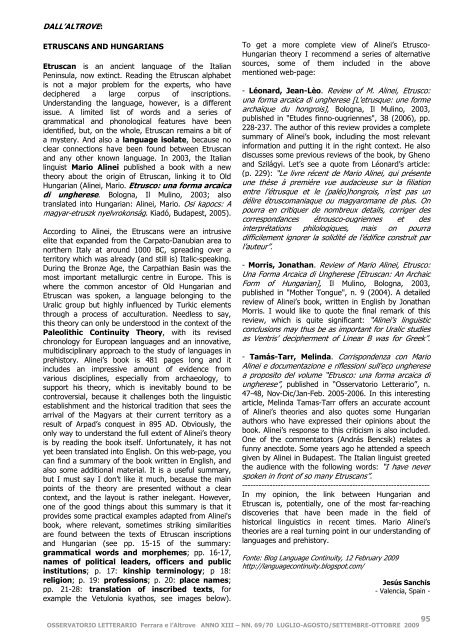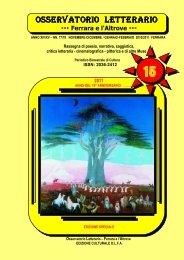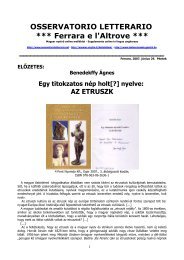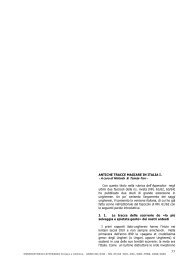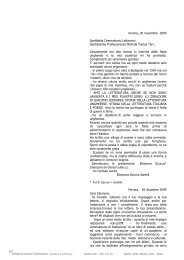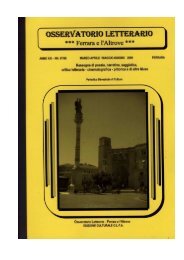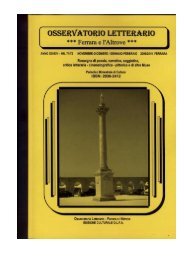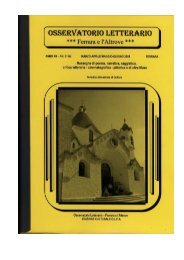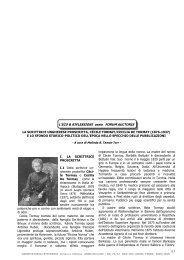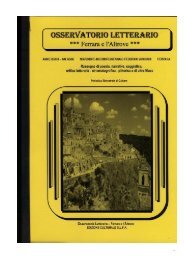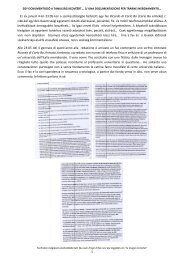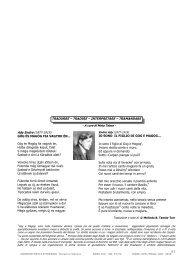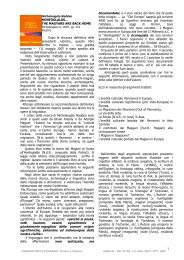NN. 69/70 LUGLIO-AGOSTO/SETTEMBRE-OTTOBRE 2009
NN. 69/70 LUGLIO-AGOSTO/SETTEMBRE-OTTOBRE 2009
NN. 69/70 LUGLIO-AGOSTO/SETTEMBRE-OTTOBRE 2009
Create successful ePaper yourself
Turn your PDF publications into a flip-book with our unique Google optimized e-Paper software.
DALL’ALTROVE:<br />
ETRUSCANS AND HUNGARIANS<br />
Etruscan is an ancient language of the Italian<br />
Peninsula, now extinct. Reading the Etruscan alphabet<br />
is not a major problem for the experts, who have<br />
deciphered a large corpus of inscriptions.<br />
Understanding the language, however, is a different<br />
issue. A limited list of words and a series of<br />
grammatical and phonological features have been<br />
identified, but, on the whole, Etruscan remains a bit of<br />
a mystery. And also a language isolate, because no<br />
clear connections have been found between Etruscan<br />
and any other known language. In 2003, the Italian<br />
linguist Mario Alinei published a book with a new<br />
theory about the origin of Etruscan, linking it to Old<br />
Hungarian (Alinei, Mario. Etrusco: una forma arcaica<br />
di ungherese. Bologna, Il Mulino, 2003; also<br />
translated into Hungarian: Alinei, Mario. Osi kapocs: A<br />
magyar-etruszk nyelvrokonság. Kiadó, Budapest, 2005).<br />
According to Alinei, the Etruscans were an intrusive<br />
elite that expanded from the Carpato-Danubian area to<br />
northern Italy at around 1000 BC, spreading over a<br />
territory which was already (and still is) Italic-speaking.<br />
During the Bronze Age, the Carpathian Basin was the<br />
most important metallurgic centre in Europe. This is<br />
where the common ancestor of Old Hungarian and<br />
Etruscan was spoken, a language belonging to the<br />
Uralic group but highly influenced by Turkic elements<br />
through a process of acculturation. Needless to say,<br />
this theory can only be understood in the context of the<br />
Paleolithic Continuity Theory, with its revised<br />
chronology for European languages and an innovative,<br />
multidisciplinary approach to the study of languages in<br />
prehistory. Alinei’s book is 481 pages long and it<br />
includes an impressive amount of evidence from<br />
various disciplines, especially from archaeology, to<br />
support his theory, which is inevitably bound to be<br />
controversial, because it challenges both the linguistic<br />
establishment and the historical tradition that sees the<br />
arrival of the Magyars at their current territory as a<br />
result of Arpad’s conquest in 895 AD. Obviously, the<br />
only way to understand the full extent of Alinei’s theory<br />
is by reading the book itself. Unfortunately, it has not<br />
yet been translated into English. On this web-page, you<br />
can find a summary of the book written in English, and<br />
also some additional material. It is a useful summary,<br />
but I must say I don’t like it much, because the main<br />
points of the theory are presented without a clear<br />
context, and the layout is rather inelegant. However,<br />
one of the good things about this summary is that it<br />
provides some practical examples adapted from Alinei's<br />
book, where relevant, sometimes striking similarities<br />
are found between the texts of Etruscan inscriptions<br />
and Hungarian (see pp. 15-15 of the summary:<br />
grammatical words and morphemes; pp. 16-17,<br />
names of political leaders, officers and public<br />
institutions; p. 17: kinship terminology; p 18:<br />
religion; p. 19: professions; p. 20: place names;<br />
pp. 21-28: translation of inscribed texts, for<br />
example the Vetulonia kyathos, see images below).<br />
To get a more complete view of Alinei’s Etrusco-<br />
Hungarian theory I recommend a series of alternative<br />
sources, some of them included in the above<br />
mentioned web-page:<br />
- Léonard, Jean-Lèo. Review of M. Alinei, Etrusco:<br />
una forma arcaica di ungherese [L'etrusque: une forme<br />
archaïque du hongrois], Bologna, Il Mulino, 2003,<br />
published in "Etudes finno-ougriennes", 38 (2006), pp.<br />
228-237. The author of this review provides a complete<br />
summary of Alinei’s book, including the most relevant<br />
information and putting it in the right context. He also<br />
discusses some previous reviews of the book, by Gheno<br />
and Szilágyi. Let’s see a quote from Léonard’s article:<br />
(p. 229): “Le livre récent de Mario Alinei, qui présente<br />
une thèse à première vue audacieuse sur la filiation<br />
entre l’étrusque et le (paléo)hongrois, n’est pas un<br />
délire étruscomaniaque ou magyaromane de plus. On<br />
pourra en critiquer de nombreux details, corriger des<br />
correspondances étrousco-ougriennes et des<br />
interprétations philologiques, mais on pourra<br />
difficilement ignorer la solidité de l’édifice construit par<br />
l’auteur”.<br />
- Morris, Jonathan. Review of Mario Alinei, Etrusco:<br />
Una Forma Arcaica di Ungherese [Etruscan: An Archaic<br />
Form of Hungarian], Il Mulino, Bologna, 2003,<br />
published in "Mother Tongue", n. 9 (2004). A detailed<br />
review of Alinei’s book, written in English by Jonathan<br />
Morris. I would like to quote the final remark of this<br />
review, which is quite significant: “Alinei’s linguistic<br />
conclusions may thus be as important for Uralic studies<br />
as Ventris’ decipherment of Linear B was for Greek”.<br />
- Tamás-Tarr, Melinda. Corrispondenza con Mario<br />
Alinei e documentazione e riflessioni sull’eco ungherese<br />
a proposito del volume “Etrusco: una forma arcaica di<br />
ungherese”, published in “Osservatorio Letterario”, n.<br />
47-48, Nov-Dic/Jan-Feb. 2005-2006. In this interesting<br />
article, Melinda Tamas-Tarr offers an accurate account<br />
of Alinei’s theories and also quotes some Hungarian<br />
authors who have expressed their opinions about the<br />
book. Alinei’s response to this criticism is also included.<br />
One of the commentators (András Bencsik) relates a<br />
funny anecdote. Some years ago he attended a speech<br />
given by Alinei in Budapest. The Italian linguist greeted<br />
the audience with the following words: “I have never<br />
spoken in front of so many Etruscans”.<br />
--------------------------------------------------------------------<br />
In my opinion, the link between Hungarian and<br />
Etruscan is, potentially, one of the most far-reaching<br />
discoveries that have been made in the field of<br />
historical linguistics in recent times. Mario Alinei’s<br />
theories are a real turning point in our understanding of<br />
languages and prehistory.<br />
Fonte: Blog Language Continuity, 12 February <strong>2009</strong><br />
http://languagecontinuity.blogspot.com/<br />
Jesús Sanchis<br />
- Valencia, Spain -<br />
OSSERVATORIO LETTERARIO Ferrara e l’Altrove A<strong>NN</strong>O XIII – <strong>NN</strong>. <strong>69</strong>/<strong>70</strong> <strong>LUGLIO</strong>-<strong>AGOSTO</strong>/<strong>SETTEMBRE</strong>-<strong>OTTOBRE</strong> <strong>2009</strong> 95


